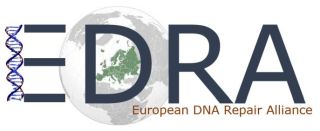|
|
|
Previous webinars > 10th webinar 12/12/202310th EDRA Webinar December 12th, 2023, from 3:30 to 5:00 pm (CET)
Angela Taddei- Keynote speaker
Institut Curie, Université PSL, Sorbonne University, CNRS, Nuclear Dynamics, Paris, France In vivo tracking of functionally tagged Rad51 sheds new light on homology search. Homologous recombination (HR) is a major pathway to repair DNA double-strand breaks (DSB). HR uses an undamaged homologous DNA sequence as a template for copying the missing information, which requires identifying a homologous sequence among megabases of DNA within the crowded nucleus. In eukaryotes, the conserved Rad51–single-stranded DNA nucleoprotein filament (NPF) performs this homology search. Although NPFs have been extensively studied in vitro by molecular and genetic approaches, their in vivo formation and dynamics could not thus far be assessed due to the lack of functional tagged versions of Rad51. We recently developped and characterized in budding yeast the first fully functional, tagged version of Rad51 (Liu et al, NSMB 2023). I will present our recent findings on the dynamics of Rad51 and its regulation during the process of homology search.
Short talks 1 - Sakis Siametis Institute of Molecular Biology and Biotechnology, Heraklion, Crete, Greece Transcription stress-associated telomere dysfunction and cellular senescence Gene regulation is inextricably linked to proper cell function and proliferation, tissue development and organismal health. However, the genome is continuously challenged by damaging agents that interfere with the process of mRNA synthesis. Although most endogenous lesions can be bypassed by the transcription machinery, bulkier or helix-distorting lesions obstruct the progression of RNA Polymerase II causing transient pauses or more detrimental arrests. As a result of such persistent lesions, transcription stress leads to cellular malfunction and ultimately to premature cell death or senescence, resulting in DNA damage-induced, accelerated aging and disease. Transcription elongation factor S-II (TFIIS), also known as TCEA, plays a key role in stimulating RNA PolII to bypass sites of oxidative damage or resume transcription following elongation arrest. Whereas correlations between transcription stress and genome instability have been established, the mechanisms underlying their impact on cell homeostasis and function remains poorly understood. To elucidate such mechanisms, we use a TCEA1 fl/fl mouse model crossed with a CMV.Cre mouse to isolate TCEA1 -/- Mouse Embryonic Fibroblasts (MEFs). Complete ablation of TFIIS results in intrinsic transcription stress, which surprisingly leads to telomere crisis and cellular senescence, following oxidative damage accumulation. Persistent and unresolved transcription-associated telomeric R-loops are also accumulated, resulting in telomeric DNA fragments release to cytoplasm, causing an inflammatory response. We further propose to investigate how a transcriptional defect can lead to this telomere-associated phenotype, describing the exact mechanism by which these events are happening and if there is a physiological connection to the telomere attrition we observe during ageing.
2 - Renée C. Duardo Department of Pharmacy and Biotechnology, University of Bologna, Bologna, Italy Human DNA topoisomerase I poisoning causes R-loop-mediated genome instability attenuated by transcription factor IIS Topoisomerase I (Top1) is a key enzyme which resolves DNA topological stress. The formation of DNA-Top1 intermediates (Top1ccs) is fundamental for the enzyme to relax negative supercoils thus preventing the formation of unscheduled R-loops, non-B DNA structures composed of an RNA-DNA hybrid and a displaced non-template strand. Top1 poisons, such as Camptothecin (CPT), cause the trapping of Top1ccs with consequent increase of R-loops and micronuclei (MNi), extra-nuclear bodies containing chromatin not included into the nucleus at mitosis. We have published that MNi formation is R-loop dependent, but molecular events downstream of Top1cc trapping remained to be fully clarified. By performing genome-wide mapping of R-loops and Top1cc-induced DNA double-strand breaks (DSBs), we found that Top1ccs increase two different types of R-loops, which can be distinguished for their kinetics and several other aspects, including genomic location relative to accumulated RNA polymerase II (RNAPII) peaks. Persistent Top1cc-related DSBs accumulate at early-replicating initiation zones in highly transcribed genes and overlap with RNA-DNA hybrids downstream to accumulated RNAPII at 5' -ends. The peculiar position of these hybrids with respect to RNAPII indicate that they can be anterior R-loops forming after RNAPII backtracking. Moreover, we found that Top1cc triggered MNi specifically at late G1 and Early/Mid S-phase but not at late S-phase. As MNi increase, transcription-replication conflicts (TRCs) and RNAPII accumulation are attenuated by the transcription factor IIS, a protein involved in RNAPII rescue after backtracking, we propose a new mechanism of Top1cc-induced TRCs and genome instability involving RNAPII arrest.
|



